
|

The placebo effect is a
psychobiological phenomenon which
involves a psychosomatic response to an environmental trigger.
The
response can be either positive or negative. Placebos are not
inert.
This response depends entirely on the both the conscious and
subconscious expectations of the
patient undergoing placebo therapy.
The outcome of the placebo
effect is entirely dependent on
the ability of the hypnotist to convince the patient treatment will
result in the desired effect.
To
facilitate mesmerization
props and rituals are
required.
Props involve the
administration of an inert substance,
as in homeopathy
or of a sham physical treatment
such as sham 'surgery'.
Critical is the ability of the
rhetorician to hold the
conscious attention of
the patient in a state of thrall - the
patient must believe the treatment will work.
"Just as there is a
positive placebo effect, so there is what I term inverse or negative placebo
effect: the expectation that something will go wrong without the psychiatric
drugs for support, the idea one needs a drug or drugs to correct one's alleged
"imbalance," and the
fear that one will go crazy without them.
The negative placebo
creates psychological
dependence on psychiatric drugs.
Those who believe in psychiatry
will be more likely to experience the placebo effect, both positive and
negative.
The faith in psychiatry is tenacious in our society; even
"revolutionaries," rebels, Marxists, feminists - those who challenge every
hegemonic institution - are
likely to place cleric faith in
modern psychiatry.
Our secular scientific age,
Psychiatry, like
medicine in general, is God.
Psychiatrists have
wrapped themselves in the shroud of science since 1990s, which was dubbed by
the US Congress and
HW Bush the Decade of the Brain." - Seth
Farber
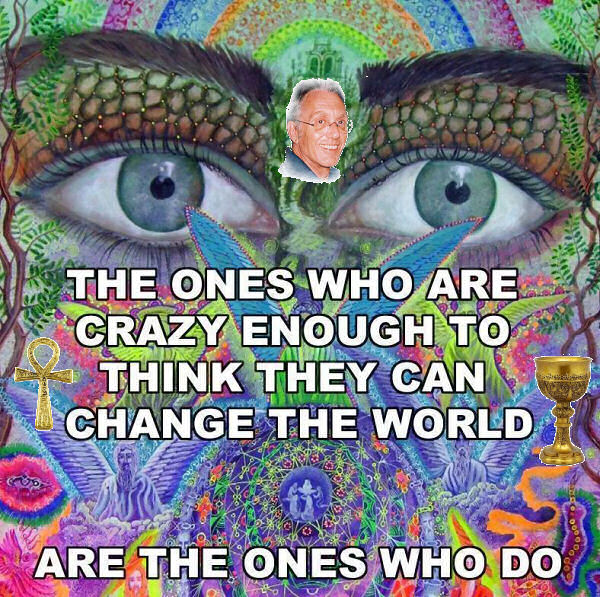
Like
fetishes, placebos have
a symbolic ambience
made of an amalgamation of
atmosphere, ritual and
psycholinguistically
chosen ritual words.
The success of the placebo treatment rest in
the neurolinguistic
ability of the rhetorician to mesmerize; to place the patient into a
hypnotic trance.
Addiction is directly related to placebo
theory.
Water soluble
manufactured chemicals are addictive in that
the body responds in a certain manner to
neutralize the toxin and wash it out.
The brain responds to
enzyme system poisoning in different
ways.
We become "acclimated" when undergoing
chemical therapy and go
into "withdrawal" as our body
attempts to return to natural
equilibrium.
Programmed by
prior chemical poisonings to respond to "medical stimulation"
with a placebo if we expect
results we soon feel them.
A person centered and grounded in
their own body will not be affected by a placebo but
they will be affected by
chemical poisoning whereas
a bodily
detached person is more likely to benefit from a placebo effect.
Most allopathic chemical poison pretending
to cure uses a combination of actual chemical poisoning and
subliminal subconscious programming that acts in
the manner of the placebo to change conscious
expectations.
Medical literature includes a great deal of testimony
that the placebo effect routinely works 30 percent of the time, with Dr.
Herbert Benson of Harvard stating that it may work up to 90 percent of the
time.
As the placebo effect routinely works 30 percent of the time there
are serious questions to be answered about
chemothearpy survival
rates.
Internist
and rheumatologist respondents agree on placebo
treatments:
679 physicians (57%) responded to the survey.
About half of the surveyed internists and rheumatologists reported
prescribing placebo
treatments on a regular basis (51±7%).
Most physicians (62%)
believed the practice to be ethically permissible.
Few reported using saline (3%) or sugar pills ( 2%) as
placebo treatments, while
large proportions reported using over the counter analgesics
(41%) and vitamins (38%) as
placebo
treatments within the past year.
A small but notable proportion of
physicians reported using
antibiotics
(13%) and sedatives (13%) as
placebo treatments during
the same period.
Physicians who use
placebo treatments commonly
describe them to patients as
a potentially
beneficial medicine or treatment
not typically used for their condition (68%);
rarely do they explicitly
describe them as placebos (5%).
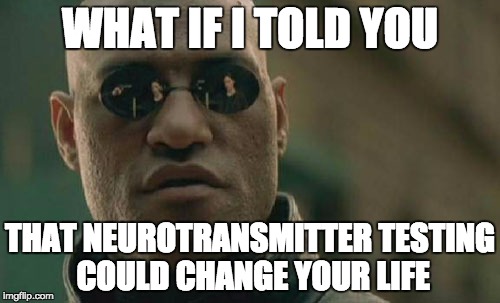
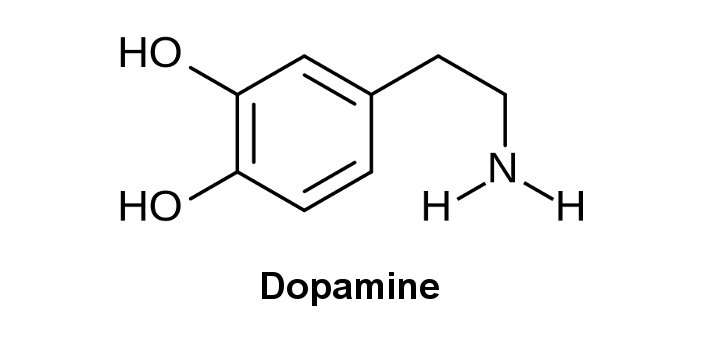
dopamine
Dopamine has many functions in the
brain, including important roles in
behavior and
cognition,
motor activity,
motivation and
reward, regulation of milk
production, sleep,
mood,
attention, and
learning.
Phasic responses of
dopamine neurons are observed when an unexpected reward is presented such
as when pleasantly surprised.
These responses
transfer to the onset of a conditioned stimulus after repeated pairings with
the reward as readily
proved in experimentation.
Dopamine neurons are depressed
when the expected reward is omitted.
Dopamine neurons encode the
prediction error of rewarding outcomes.
In nature,
we learn to repeat behaviors
that maximize rewards.
Dopamine provides a teaching
signal for acquiring new behavior.
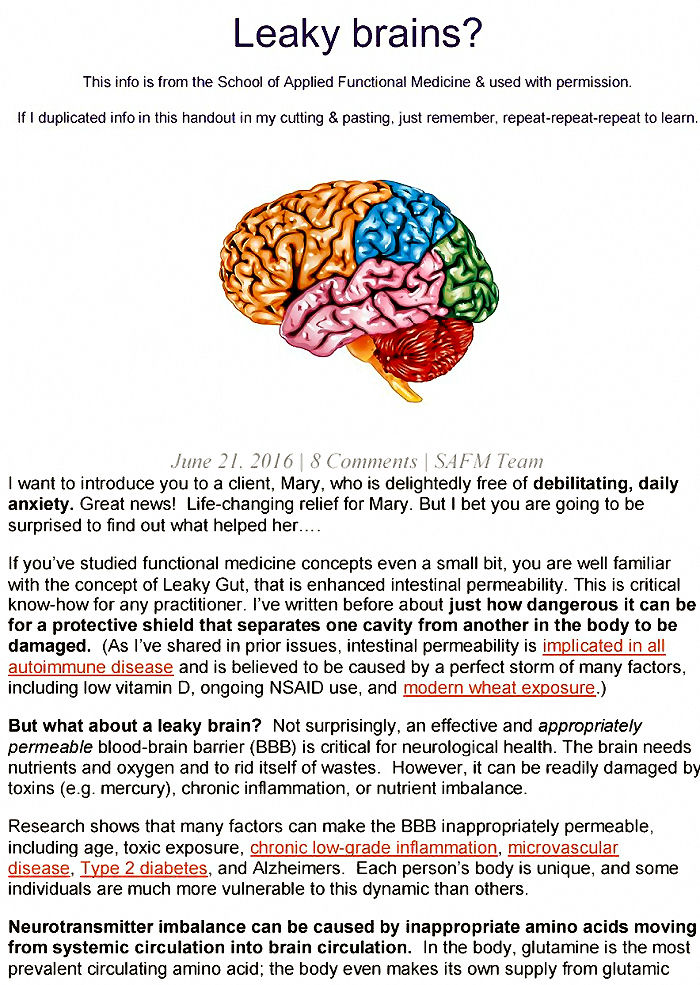
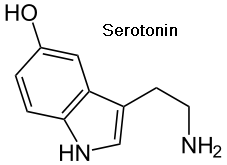
serotonin
Serotonin is primarily
found in the gastrointestinal enteric nervous system but also in blood
platelets and the throughout the central nervous system.
90% of total
serotonin in the human body is located in the enterochromaffin cells in
the gastrointestinal system, where it
regulates intestinal movements.
Throughout the
central nervous system
serotonin plays an important role as a neurotransmitter in the
regulation of anger,
aggression,
body temperature,
mood,
sleep,
vomiting,
sexuality, and
appetite.
Serotonin is
also produced in the
Raphe nuclei located in the brainstem.
Serotonin stored in blood
platelets is released during agitation
and vasoconstriction where it then acts as an agonist to other platelets.
With all neurotransmitters, the effects of
serotonin on the human mood
and state of mind, and
its role in consciousness,
are difficult to fully
quantify.
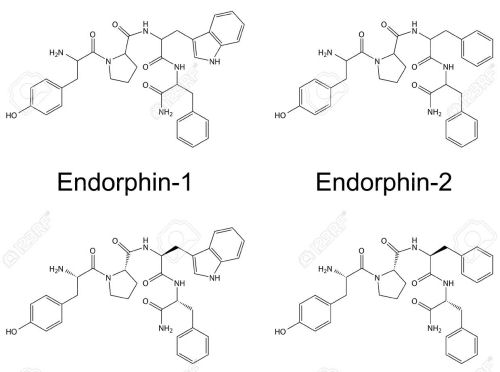
endogenous opioid
peptides
There are three
well-characterized families of opioid peptides produced by the body:
enkephalins, endorphins and dynorphins.
An
enkephalin is a pentapeptide involved in regulating pain and
nociception.
The
enkephalins are termed endogenous ligands, or specifically endorphins, as they
are internally derived and bind to the body's opioid receptors.
Opiates
resemble endorphins by produce analgesia and a
sense of well-being.
Endorphins are "natural pain killers."
Other drugs may increase
the effects of the endorphins.
The term "endorphin" implies a
physiological activity.
It consists of two parts: endo- and -orphin;
short forms of endogenous and opium meaning "a morphine-like substance
originating from within."
The term endorphin rush has been
adopted in popular speech to refer
to feelings of exhilaration
brought on by pain, danger,
or other forms of stress.
Dynorphin is a class of peptides which has some opiate-like activity.
The dynorphins, which include dynorphin A, dynorphin B, alpha- and
beta-neoendorphin, big dynorphin;
products of a single
gene - preprodynorphin.
Dynorphin functions primarily as a kappa
opioid receptor agonist, meaning that it acts mainly at kappa opioid receptors.
Other opioid peptides include beta-endorphin, met-enkephalin,
leu-enkephalin and endomorphins.
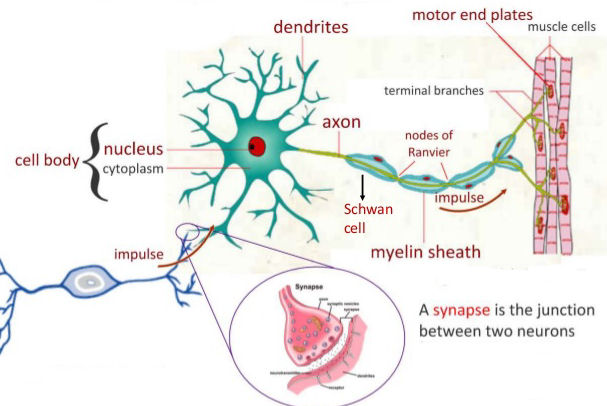
One of the most important
features of neuron
synapses is that they are the site of action for the majority of
psychoactive drugs.
Neuron synapses are affected by drugs such as
curare,
strychnine,
cocaine™,
opium,
alcohol,
LSD, and
countless
others.
Neuron synapses suffering
demyelination are
susceptible to blood brain
barrier breaches.
These drugs have different effects on synaptic
function, and often are restricted to
neuron synapses that use a
specific neurotransmitter.
Curare is a poison which stops acetylcholine
from depolarising the post-synaptic membrane, causing
paralysis.
Strychnine blocks the inhibitory effects of the neurotransmitter
glycine, which causes the
body to pick up and react to weaker and previously ignored stimuli, resulting
in uncontrollable muscle contractions.
Ethanol increases
the inhibitory effects of the neurotransmitter GABA.
Morphine
hydrochloride acts on endorphin synapses.
Cocaine hydrochloride blocks
reuptake of dopamine, increasing effects.
Lysergic acid interferes with
serotonin synapses causing hallucination.
Entheogens
modulate the serotonin system to produce
psychedelic alterations
in perception, emotional
response, and thought
process'.
Psilocybin,
mescaline,
n,n-dimethyltryptamine,
lysergic acid diethylamide,
3,4-methylenedioxymethamphetamine,
4-hydroxy-N,N-dimethyltryptamine,
Tabernanthe iboga and
3,4-methylenedioxy-n-ethylamphetamine.



" Let us then endeavour
to disperse those clouds of ignorance,
those mists of darkness,
which impede man on his journey,
which obscure his progress, which prevent his marching through life with a firm
steady grip.
Let us inspire him
with courage to respect his
reason and an inextinguishable
love for truth - with
a remembrance of
Galileo Galilei:
to the end that he may
learn to know himself;
to know his legitimate rights and
dare to care for himself;
that he may learn to
consult his experience;
no longer be the dupe of
an imagination led
astray by authority;
that he may
renounce the prejudices of
childhood;
that he may learn to found his wants to
the real advantage of
society;
that he may pursue true happiness by promoting the happiness
of others;
in short, that he may no longer occupy himself with
reveries either useless or
dangerous so he may become a virtuous rational being.
Man
should learn happiness is simply
an emanation formed of
reflection.
Each individual
a sun within himself
continually shedding genial rays
creating reflections
of requisite heat enabling him to
generate kindly fruit.
The happy man is he enjoys the
benefits bestowed upon him by
nature.
He who thinks
for himself is thankful for the life he
possesses.
After all, who does
not envy the welfare of others, nor
sigh after imaginary benefits always beyond his grasp?" - Paul-Henri Thiry,
Baron d'Holbach


"I should not infer the pursuit of pleasure is necessarily
futile.
The principle of Egoistic Hedonism, when applied with a due
knowledge of the laws of
human nature, is practically
self-limiting.
A rational method of attaining the end we aim for
requires that we should to some extent
put it out of sight and not directly
aim at it." - Henry Sidgwick
"Happiness is actually an
attainable goal, if we detach
ourselves from knee jerk
responses to habituation and
what we think we
must avoid at all costs.
True attainable happiness is the
state of consciousness that allows us to
embrace whatever comes our way with
equanimity."- Peter Clothier

the myth of happiness
Written into the
Declaration of
Independence of the United States of America is
the right of all
Americans to pursue happiness.
At this time in space happiness was
considered to be of an
individual nature.
An individual could be happy
or unhappy.
Blueprints
for happiness were based upon individual experience involving the
exercise of mind or body and some sort of discipline even for
Epicurus.
With
the advent of
collectivism blueprints were replaced with
a vision of collective material
well-being, happiness
lifting all boats by the careful manipulation of
derivatives
and futures
markets by financial
engineers!
Happiness is now owed to all and consists in
a collective increase of
wealth.
The myth of the
ability to attain happiness through material possessions is what enables
mankind to regard life as worth living in
MICE culture.
All activity must be
subordinated exclusivly to increase material wealth.
Anyone who
challenges the "material wealth is the
only path" myth of happiness is looked upon by friends as addled and
branded as
crazy.
"We
all have the tendency to struggle
in our bodies and our
minds.
We believe that
happiness is possible only in the future.
The realization that we have
already arrived, that we
don't have to travel any further, that
we are already
here, can give us contentment and
bliss.
We only need to allow ourselves to be in the present
moment.
What are we looking
for to be happy? Everything
is already here.
We do not need to put
a prize in front of us to
run after and
possess.
That golden
ring is always in the future, and we can never catch up to it.
We are already in the Pure
Land, the Kingdom of Heaven.
We only need to wake up and
realize we are here." -
Thich Nhat Hanh

gross national
happiness
The country of Bhutan, the last
surviving refuge of traditional Himalayan Buddhist culture, uses Gross National
Happiness (GNH) is an attempt to define quality of life in more holistic and
psychological terms than Gross National Product(GNP).
The term, Gross
National Happiness, is coined by Bhutan's King Jigme Singye Wangchuck in
1972.
It signaled his commitment
to building an economy that would serve Bhutan's unique culture based on
Buddhist spiritual values.
The
four pillars of Gross National Happiness are the promotion of equitable and
sustainable socio-economic development, preservation and promotion of cultural
values, conservation of the natural
environment, and establishment of good governance.
Gross National
Happiness is qualitative and discussed in tandem with the Genuine Progress
Indicator which attempts to quantify well-being.
Well-being is more relevant and
important than consumption.
 |
|
 |
This web site is not a commercial web site and
is presented for educational purposes only.

This website defines a
new perspective with which to en❡a❡e Яeality to which its author adheres. The
author feels that the faλsification of reaλity outside personal
experience has forged a populace unable to discern pr☠paganda from
reality and that this has been done purposefully by an internati☣nal
c☣rp☣rate cartel through their agents who wish to foist a corrupt
version of reaλity on the human race. Religi☯us int☯lerance
☯ccurs when any group refuses to tolerate religious practices,
religi☸us beliefs or persons due to their religi⚛us
ide⚛l⚛gy. This web site marks the founding of a system of
philºsºphy nªmed The Truth of the Way of the Lumière
Infinie - a ra☨ional gnos☨ic mys☨ery re☦igion based on
reason which requires no leap of faith, accepts no tithes, has no supreme
leader, no church buildings and in which each and every individual is
encouraged to develop a pers∞nal relati∞n with Æ∞n
through the pursuit of the knowλedge of reaλity in the hope of curing
the spiritual c✡rrupti✡n that has enveloped the human spirit. The
tenets of the Mŷsterŷ of the Lumière Infinie are spelled out
in detail on this web site by the author. Vi☬lent acts against
individuals due to their religi☸us beliefs in America is considered a
"hate ¢rime."
This web site in no way c☬nd☬nes
vi☬lence. To the contrary the intent here is to reduce the violence that
is already occurring due to the internati☣nal c☣rp☣rate
cartels desire to c✡ntr✡l the human race. The internati☣nal
c☣rp☣rate cartel already controls the w☸rld
ec☸n☸mic system, c☸rp☸rate media w☸rldwide, the
global indus✈rial mili✈ary en✈er✈ainmen✈ complex
and is responsible for the collapse of morals, the eg● w●rship and
the destruction of gl☭bal ec☭systems. Civilization is based on
coöperation. Coöperation with bi☣hazards of a
gun.
American social mores and values have declined precipitously over
the last century as the corrupt international cartel has garnered more and more
power. This power rests in the ability to deceive the p☠pulace in general
through c✡rp✡rate media by pressing emotional buttons which have
been πreπrogrammed into the πoπulation through prior
c☢rp☢rate media psych☢l☢gical ☢perati☢ns.
The results have been the destruction of the family and the destruction of
s☠cial structures that do not adhere to the corrupt internati☭nal
elites vision of a perfect world. Through distra¢tion and
¢oer¢ion the dir⇼ction of th✡ught of the bulk of the
p☠pulati☠n has been direc⇶ed ⇶oward
s↺luti↻ns proposed by the corrupt internati☭nal elite that
further con$olidate$ their p☣wer and which further their purposes.
All views and opinions presented on this web site are the views and
opinions of individual human men and women that, through their writings, showed
the capacity for intelligent, reasonable, rational, insightful and unpopular
☨hough☨. All factual information presented on this web site is believed to be
true and accurate and is presented as originally presented in print media which
may or may not have originally presented the facts truthfully. Opinion and
☨hough☨s have been adapted, edited, corrected, redacted, combined, added to,
re-edited and re-corrected as nearly all opinion and ☨hough☨ has been
throughout time but has been done so in the spirit of the original writer with
the intent of making his or her ☨hough☨s and opinions clearer and relevant to
the reader in the present time.
Fair Use Notice

This site may contain
copyrighted material the use of which has not always been specifically
authorized by the copyright owner. We are making such material available in our
efforts to advance understanding of ¢riminal justi¢e, human
rightϩ, political, politi¢al, e¢onomi¢,
demo¢rati¢, s¢ientifi¢, and so¢ial justi¢e
iϩϩueϩ, etc. We believe this constitutes a 'fair use' of any
such copyrighted material as provided for in section 107 of the US Copyright
Law. In accordance with Title 17 U.S.C. Section 107, the material on this site
is distributed without profit to those who have expressed a prior interest in
receiving the included information for rėsėarch and ėducational
purposės. For more information see:
www.law.cornell.edu/uscode/17/107.shtml. If you wish to use copyrighted
material from this site for purposes of your own that go beyond 'fair use', you
must obtain permission from the copyright owner. |
 Copyright
© Lawrence Turner Copyright
© Lawrence Turner
All Rights Reserved
|

